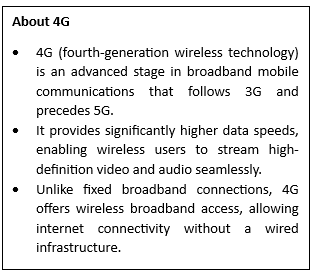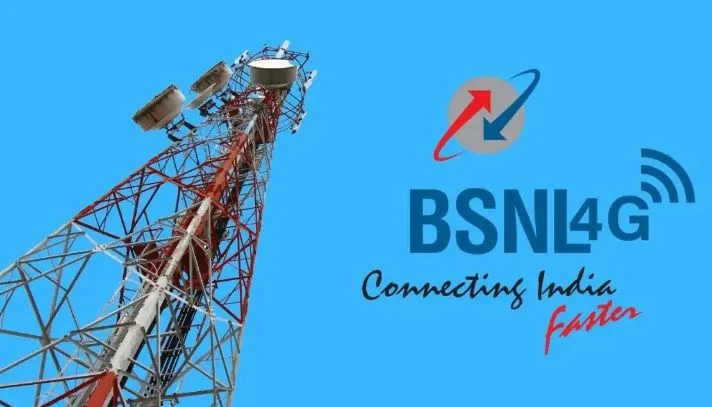Syllabus:
GS-3: Awareness in the fields of IT, Space, Computers, robotics, nano-technology, bio-technology and issues relating to intellectual property rights.
Context:
In a major boost to India’s telecommunications infrastructure, the Prime Minister inaugurated BSNL’s indigenously developed ‘Swadeshi’ 4G stack, marking the country’s entry into a select group of nations that manufacture homegrown telecom equipment.
More on the News
- The core network, developed by C-DOT, with Tejas Networks’ Radio Access Network and integration by TCS, exemplifies a major technological breakthrough and the realization of the Government’s commitment to Aatmanirbhar Bharat., including , built at a cost of around
- Commissioning of 97,500 new 4G mobile towers, including 92,600 sites powered by indigenous technology, built at a cost of around ₹37,000 crore.
Towers are solar-powered, forming the largest green telecom cluster in India. - The cloud-based, future-ready network can seamlessly upgrade to 5G, placing India alongside countries such as Denmark, Sweden, China, and South Korea in telecom manufacturing capability.
- The rollout is being seen as a transformative step under the Digital India vision, bridging the digital divide, empowering rural communities, and laying the groundwork for BSNL’s 5G upgrade and integration.
- Over 26,700 unconnected villages, including 2,472 of Odisha, in remote, border, and left-wing extremism-affected areas will receive connection with this launch.
- Launch of the 100% 4G saturation network under the Digital Bharat Nidhi, which will connect an additional 29,000–30,000 villages in a mission-mode project.
Features of 4G stack

- End-to-end indigenous stack:The indigenous 4G stack integrates Radio Access Network (Tejas), Core Network (C-DOT), and domestic integration, reducing foreign dependence and boosting local capability.
- Software-first/ cloud native:It is cloud-native and software-driven, enabling fast upgrades, scalability, and smooth migration to 5G.
- Future proofing:The infrastructure is 5G-ready, allowing upgrades without replacing existing equipment, ensuring cost-effective future-proofing.
Benefits of the indigenous 4G Stack
- Strategic Autonomy and Digital Sovereignty: India’s fully indigenous 4G stack gives the nation control over its telecom infrastructure, cuts foreign dependence, and enhances national security.
- Employment generation and supply-chain development:India’s indigenous 4G stack supports local manufacturing and deployment, creating jobs, strengthening supplier networks, and building a skilled workforce.
- Catering to domestic demand with global potential:The fully indigenous 4G stack is not only meeting India’s internal requirements but is also designed with export potential, with several countries having already expressed interest.
- Rapid development through indigenous capability:The entire 4G architecture was indigenously built in just 22 months, a pace significantly faster than comparable nations.
- Realisation of the Swadeshi principle:The deployment reflects the Swadeshi ethos, transforming an idea into a growth engine that promotes domestic production, cultivates indigenous skills, inspires community enterprise, and embeds economic dignity into everyday life.
5G Rollout & Bharat 6G Vision
- 5G services launched in October 2022, now available in all 28 states and 8 Union Territories, covering nearly all districts nationwide.
- By June 30, 2025, telecom providers installed 4.86 lakh 5G Base Transceiver Stations (BTS) across the country.
- India’s 5G rollout is among the fastest globally, significantly expanding coverage and user access.
- India’s swift 5G rollout and widespread adoption are creating a strong foundation for the Bharat 6G Mission, positioning the country as a global leader in next-generation telecom innovation.
- India released the “Bharat 6G Vision” on March 23, 2023, aiming to make the country a leading player in 6G design, development, and deployment by 2030, guided by affordability, sustainability, and universality.
Uses of 5G
- Agriculture: This enables precision farming using IoT sensors, drones, and AI for better productivity and resource use.
- Healthcare: It supports telemedicine, remote diagnostics, and real-time health monitoring, improving rural healthcare access.
- Manufacturing & Industry 4.0: It facilitates automation, robotics, and smart factories with reliable, low-latency connectivity.
- Smart Cities: This powers intelligent traffic management, energy-efficient infrastructure, safety, and environmental monitoring.
- Automotive & Transport: It enables connected/autonomous vehicles, real-time traffic updates, and safer roads.
- Entertainment & Media: It provides high-definition streaming, immersive gaming, and interactive media experiences.

